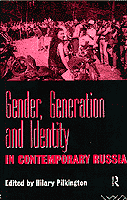
![]()

Gender images are being recast in Russia. Whereas in the past women and men were supposed to contribute equally to the labour market, this coincided with strong 'biologically' derived gender stereotypes. The contributors describe a re- masculinization of Russian culture with new ideals of 'maleness' and 'femaleness'. The ideal man is now one who earns money, is aggressive, successful and confident. The ideal woman - in contrast to the Soviet ideal - is gentle, meek, submissive and not committed to the labour market as strongly as her predecessors. The ideal woman is glamorous. In fact many men are not able to fulfil this ideal and the contributions to the volume show that women also have other strategies - they often hold managing or powerful positions and are anything but meek and submissive. However, they increasingly use their femininity to get what they want in the labour market and this shades into sexual exploitation. Evidently, sexual harrasment was and still is common although seldom discussed. Pilkington concludes that at least with these new gender stereo-types the exploitation is more out in the open: 'the gloves are off' as she puts it.
According to some of the contributors, the 'new woman' sometimes suffers from a 'masculinity complex' by which she expects to manage everything - success in the labour market as well as bringing up children in the home and fulfilling new ideals of glamour. According to Elena Dmitrieva, one of the contributors, this has roots in the roles which Russian women performed under different regimes over the last century. Women were often left in charge of families and of the workplace.
Young women are entering a brutally sexist world where a common practice in youth cultures is gang rape as a form of social control according to Elena Omel'chenko. Hilary Pilkington herself records the changes in the youth cultural scene in Moscow since she first began her studies of it and concludes that these take four main forms: the growing importance of drugs; the growing importance of the club scene rather than the streets as the stage upon which sub-cultures are acted out; the growing importance of chauvinist politics reflected in anti-foreigner feeling and the development of skinheads and finally, the increasing emergence of gay and lesbian youth sub-cultures. The newly commercialized and uncensored sex industry or becoming a bride chosen from a catalogue for 'western' men are also part of the reality confronting young women growing up in Russia at the end of the 20th Century.
The contributions also however emphasize the diversity of young women's experiences, their control and manipulation of the situation and the increase in 'partnership' styles of marriage rather than more traditionally gender-skewed ones.
Altogether this is a fascinating book which reflects a range of contemporary views in a rapidly changing national context.
Claire Wallace
Institute of Advanced Studies, Vienna and University of Derby, UK